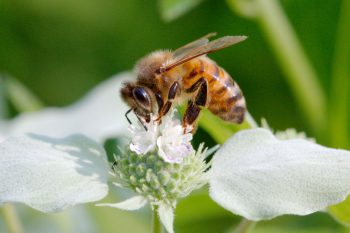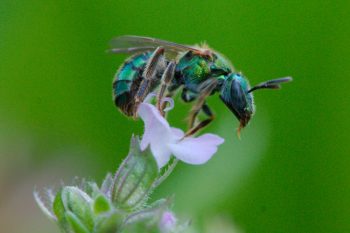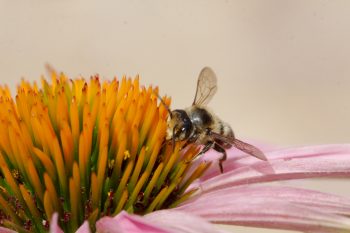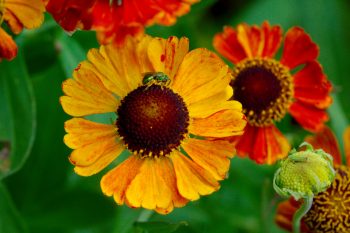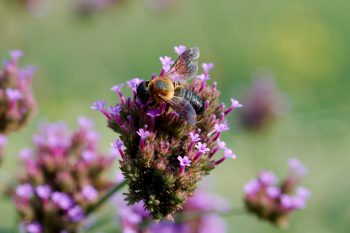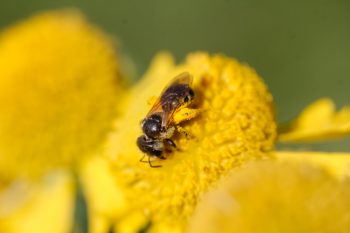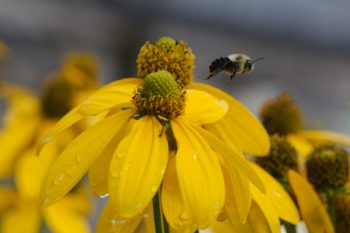The mountain mint (Pycnanthemum muticum) is starting to bloom. I won’t claim it’s a hive of activity yet, but there’s certainly a bit of a buzz. Mostly I’m seeing honey bees (Apis mellifera) on them so far, but the mountain mint is very attractive to a wide variety of insect life from small beetles and bugs to bees and wasps, and some butterflies. The buddleia next to this tends to get more butterflies, though. It loves the sun and the insects are out in the most fierce in the heat of the day. Not my favorite time to sit there with my camera but it’s sometimes worth the effort.
Tagged With: Bee
Honey Bee (Apis mellifera)
Green-Sweat Bee
I was out with my macro on a 25mm extension tube this evening and got a few decent photos of this green bee. I labeled it a cuckoo wasp at first, but now I’m thinking it’s a green-sweat bee (Tribe Augochlorini). But don’t hold me to that. If I get a better identification, I’ll update this post. For now, all I can say for sure is that it’s a bee (Anthophila). I can also say that it’s quite pretty. It was moving around quit a bit and this was the best I could do at ISO 800, f/8, 1/100 second.
Resin Bee on Coneflower
I wasn’t happy with most of the pictures I took today, but this one isn’t too bad. I’m pretty sure this is a sculptured resin bee (Megachile sculpturalis), although there are a few other Megachile species it could be (e.g. the flat-tailed leaf-cutter bee, Megachile mendica, which is more common). Regardless, it’s a nice, quiet little bee and it was moving among the coneflowers, along with a few other solitary bees and an occasional honey bee (Apis mellifera). I know that some folks are not fond of bees and don’t like to have them around. With the exception of a few aggressive hornets and wasps, I like having them around. They really rarely sting unless provoked and they are quite pretty to watch on flowers.
Sneezeweed (Helenium ‘Mardi Gras’)
Cathy bought a few perennials over the weekend and I planted this one yesterday. It’s a sneezeweed called ‘Mardi Gras’ and it’s really nice. The flowers have a similar look to black-eyed Susans but it’s a different genus (Helenium). I happened to catch it with a little, green-sweat bee on it, which is a bonus. It prefers somewhat barren ground and isn’t supposed to do well in heavy clay, which is probably why I haven’t seen it around here. That’s really all we have. But hopefully it will survive, even if it doesn’t thrive too well.
Megachile sculpturalis (Sculptured Resin Bee)
I’m pretty sure this is a sculptured resin bee (Megachile sculpturalis), a fairly common, solitary bee in the Megachilidae family (the leafcutter, mason, and resin bees, and allies). We see them on a variety of flowers in our yard. This one is on the Verbena bonariensis (tall verbena or Brazilian vervain) and that seems to be a favorite for these bees. Like most bees, they are not at all agresive and much more likely to fly away from you than bother you in any way. I think they’re quite pretty, with their furry thorax and sculptured abdomen.
Pollinator
This little bee is absolutely loaded with pollen. (Side question: if pollen is spelled with an ‘e’, why does pollinator have an ‘i’ in its place?) Anyway, Cathy and I went to Meadowside Nature Center this afternoon and walked around a pond and through the woods. In addition to this little bee, I got a pretty good photo of a common whitetail (Plathemis lydia), a fairly common dragonfly. But I thought I’d go with the bright yellow of this photo instead. I’m also partial to bees, of course.
Honey Bee on Aster
Cathy and I took a walk along Croyden Creek early this afternoon. It has turned cool, although with the humidity in the woods and the steep nature of the trail, I was fairly warm. It was nice to get out, of course, and we only saw a few other people. We walked from the Croyden Creek Nature Center down stream almost to where it joins Rock Creek. Coming back, we turned up a side valley and came out between the two main parts of Rockville Cemetery. Back and the nature center, I took this photo of a western honey bee (Apis mellifera) on an aster of some sort.
Busy As A…
Cathy and I went to Stadler Nursery late this morning. I bought a ninebark (Physocarpus opulifolius) called ‘Fireside’. It has very dark leaves which are a really lovely red early in the year and darken until they are nearly black in the late summer and fall. As usual I also took some flower photos. Getting an insect on the wing is not something I’ve had much success doing but this one turned out pretty well. It’s a common eastern bumble bee (Bombus impatiens) leaving a Rudbeckia ‘Herbstonne’ flower. We have a lot of Rudbeckia in our yard but most of it is one variety that is quite invasive. I wouldn’t mind thinning that out and replacing some with different types and this one is pretty nice.

